Go Back to current column
Simple Light…Eloquent Light
Fine portraits don’t always require a big setup
By Frank Van Riper
Photography Columnist
The great location photographer Neil Selkirk, speaking nearly 30 years ago at the Maine Photographic Workshops, exhorted his students not to become obsessed with all the gadgets and gewgaws of studio photography: strobes, softboxes, umbrellas, gobos, snoots, hot lights—all manner of things to modify or channel artificial light.
Not that Neil wasn’t adept at using all these toys: in fact, at the time he was a greatly in-demand location shooter who traveled the world doing annual reports for big ticket companies, often creating gorgeous images in less-than-spectacular settings, thanks to his ability to create the atmosphere he needed using all the goodies toted by his willing assistants.
But during this long-ago week in Rockport, Maine, Neil did not shill for more equipment. He preferred instead to preach this gospel:
“If the conditions are perfect just make the picture.”
In fact, Neil’s class—in which I was an eager participant, wondering back then if I should jump from being a veteran newspaper reporter to being a fledgling professional photographer--was really more a Spartan boot camp than it was a tutorial on using photographic gadgetry. I remember sitting with my colleagues in a gizmo-laden studio/classroom in Union Hall salivating to try all the light modifiers that literally hung from the ceiling above us.
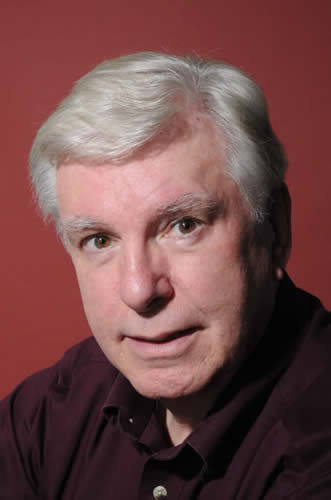 |
| I made this studio flash portrait of voice teacher Jack Fergusson this month at the SummerKeys Music school in Lubec, Me. It's OK, but Judy showed me the light...natural light...and it made for a much better shot. (see below) [all images (c) Goodman/Van Riper Photography] |
We’re not going to use those, Neil said moments after he greeted us.
Instead, during our week-long lighting master class, Selkirk rode us like a drill sergeant to actually see light: reflected light, incident light, and (my favorite) “coincidental” light—a term Neil made up to describe light so subtle, so otherwise invisible, that its presence in a photograph is merely a happy coincidence.
[To be fair, we eventually did play with the toys, but not before we made pictures using all manner of unconventional light sources. I, for example, made a portrait of my wife and partner Judy by the light of a glowing burner on an electric range.]
Neil’s demanding exercise was identical to what every art student goes through when he or she starts drawing. Drawing, after all, is looking at—and seeing—the quality of light on a subject, then translating those values to a sheet of paper, sometimes forgetting all about the subject itself. The result, if done right, will transform the subject from actual object to created image on a drawing pad, as if by magic.
In much of the commercial photography that Judy and I now do, especially involving formal portraiture for websites or annual reports, we tend to fall back on created light (via softbox, shoot-through umbrella, etc.) simply because we have neither the time nor the opportunity to wait for perfect conditions in which to work. Virtually all of our commercial work is in or around Washington, DC. It often involves lawyers, politicians, lobbyists or other such types, and there, as the saying goes, time is money. That is why a couple of recent portrait shoots, each very different and each involving, not guys in suits but professional musicians, were such a pleasure to do since each involved perfect conditions that allowed us to concentrate on the image—and not on a passel of lighting gear.
Once more we were in Maine, this time in the tiny coastal town of Lubec, literally the easternmost point in the United States. There, the SummerKeys music workshop offers the kind of intense study in music that the (now-called) Maine Media Workshops offer in photography—the kind of marvelous total immersion that musicians, and photographers, yearn for all year long. So simpatico—and effective—are classes at SummerKeys that many of its students come back year after year after year. (For information: www.summerkeys.com)
Judy and I have lived in Lubec during the summer for more than 20 years and have come to know virtually all of the musicians who teach there, especially director and founder Bruce Potterton. In fact, during an end-of-summer dinner last year, Bruce, Judy and I came up with the idea for the Lubec Photo Workshop that we now offer through SummerKeys. This summer’s two weeks of intense photo classes were such a huge success that we look forward to continuing them every summer. (More on this in a future column.)
At SummerKeys two of our longtime friends, voice teacher Jack Fergusson and classical guitarist Winslow Browning, needed new portraits--Jack to replace an existing publicity shot; Winslow needing images for his new album. In each case, Judy and I were delighted to oblige. Jack had graciously let our workshop students photograph his classes and Winslow had gone out of his way to give private guitar lessons to our visiting grandson Max.
Jack’s job was the simpler of the two: a fairly standard portrait, shot indoors against a seamless backdrop. Winslow’s was more involved: atmospheric outdoor portraits of him and his guitar as he posed literally at the edge of America, overlooking Johnson Bay amid the lengthening shadows of an early summer evening.
I admit: I assumed we simply would use studio strobe for Jack’s portrait, in this case a quantum Q-Flash with a milky diffusion head held at camera left to give Jack’s face a nice bit of modeling, but not so direct as to make the portrait look like a passport photo. The first couple of flash images, made indoors around noon on a very sunny day, looked fine but Judy—noticing the big picture window behind me that showered the room—and Jack—with light, urged me to bag the flash and just shoot available.
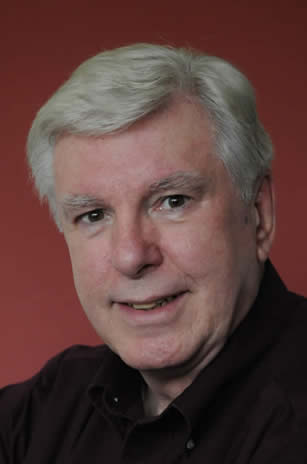 |
| Natural light shot of Jack has much more pleasing modeling around nose and the left side of his face. |
It was great advice. The huge wash of bright sunlight, normally a harsh light source at best, became diffused and flattering as it came through the big window, washed over Jack, then reflected off the seamless paper. The light was directional enough to create pleasant modeling on Jack’s face and the residual reflection off the seamless created an unexpected, though welcome, graduated light on the background paper that mimicked the look of a studio strobe placed behind a subject and aimed at the seamless to create separation.
All this and prominent catchlights in the subject’s eyes, created by that big picture window behind me.
In some respects, the job could not have been easier, and the available light photos were, to our mind, obviously better than the ones we made with flash.
A week later we shot Winslow and managed to use a number of things to our advantage as well, not least of which was the gorgeous golden “magic” light right before sunset.
[And, yes, we did use a little fill-flash for some of the shots, though hardly all of them.]
I had scoped the setting a few days before, during one of Max’s guitar lessons, held in the wood-paneled main floor of the home that SummerKeys had rented for Winslow and his wife, partner and fellow music teacher flutist Suzanne Gilchrest. Though small, the house had a million-dollar view of Johnson Bay and Winslow said he often practiced in its tiny backyard that was rimmed my wild rugosa rose bushes. Here, I thought, was where Judy and I would work—if the weather held. Happily it did—in fact the light on the evening of the shoot was a gift from the Photo God Luminessa.
The first shots we made were by available light and showed Winslow seated with his guitar and with the bay in the background. A tree on the right provided nice framing. Spot metering on Winslow’s face provided a baseline exposure.
For variation—and also to bring up more of the background—I tried a few shots with fill-flash: nothing fancy, just my trusty Vivitar 285 held out to my left to mimic the direction of the sunlight. These shots allowed me to shoot at a smaller aperture to bring up the background, and also gave the subject a little more “snap.”
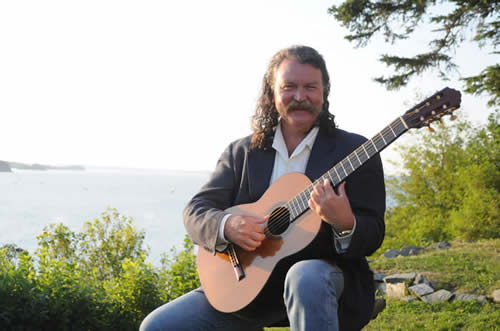 |
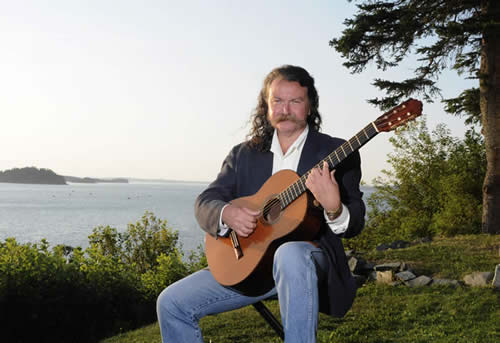 |
| Variations on a theme: Top shot of classical guitarist Winslow Browning was made with available light; bottom with a touch of fill-flash to create more 'snap' and to darken background. |
Which shot is better? Got me. But it’s always nice to give a client a choice.
Next we made the environmental shots I had thought of from the first time I had seen the backyard. This also allowed us to work with the sun nearly behind us, not off to our side, as in the first shots. And here we also used the house’s back stairs to shoot from above. This provided some drama—and, as Judy noted, had the added advantage of providing a more flattering portrait angle. All these shots were made by available light and provided some of the best images of the evening.
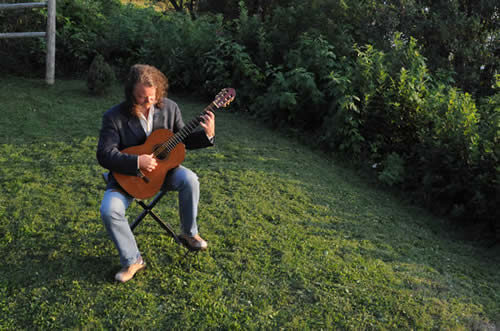 |
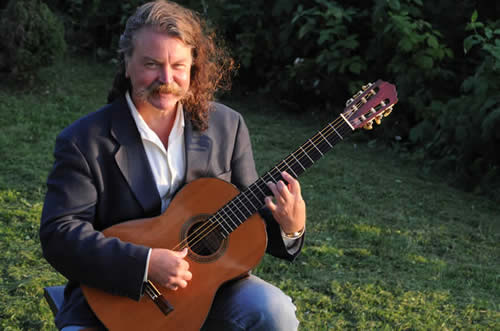 |
| Turning the tables (or in this case our subject) gave us a different lighting perspective. Shooting from above also provided a more flattering angle. |
After making a couple of informal snaps of Winslow and Suzanne together, Judy and I packed up, knowing we had great stuff. What I did not know was that Luminessa had provided us with one final gift.
One of the very first images I had made—while checking exposure, actually, and being only partially aware of my subject—turned out to be a dramatic, almost abstract, portrait of Winslow looking down, holding his guitar in his right hand, late afternoon light raking the right side of his face and nose…
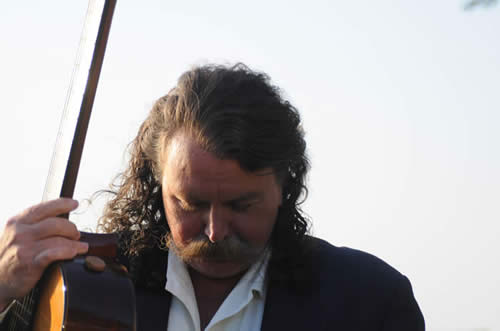 |
| The strong graphics of this image help create a dramatic available light portrait. Do I mind that it was a grab shot? Not at all. |
I loved the shot and included it in the take I shipped to Winslow. After all, one should never question a gift from the Photo Gods, especially when it could make a good album cover.
First Look at FVR Fall/Winter classes,
Glen Echo Park, Md.
Narrative Photo: The Picture Story ($300)
Thursday, Sept. 24-October 22, 7-10:30pm
Continue or begin a documentary photography project under the eye of a nationally acclaimed photographer and journalist. Grow more comfortable photographing people while recording the world around you. Film or digital welcome. Accompanying text encouraged, but not required.
Great Portraits with Simple Lighting ($275)
Class 1: Thursday, October 29-Novmber 19, 7-10:30pm
Class 2: Thursday, January 21-February 11, 7-10:30pm
Achieve studio-quality results with equipment as simple as a flashlight, aluminum foil and a toilet paper tube. A great way to learn the basics and have fun doing it.
National Gallery, East Wing, Field Trip ($150)
Class 1: Sunday, October 18
Class 2: Sunday, January 17
Spend the day photgraphing in one of Washington's great spaces, where opportunities for landscape, abstract and portrait photography abound. There will be an orientation session about a week before, followed by a potluck dinner and critique at Frank's home after the field trip.
For information contact: GVR@GVRphoto.com or go to www.glenechopark.org
Frank Van Riper is a Washington-based photographer, journalist and author. He served for 20 years in the New York Daily News Washington Bureau as White House correspondent, national political correspondent and Washington bureau news editor, and was a 1979 Nieman Fellow at Harvard. Among others, he is the author of the biography Glenn: The Astronaut Who Would Be President, as well as the photography books Faces of the Eastern Shore and Down East Maine/ A World Apart. His book Talking Photography is a collection of his Washington Post and other photography writing over the past decade. His latest book (done in collaboration with his wife and partner Judith Goodman) is Serenissima: Venice in Winter. Van Riper’s photography is in the permanent collections of the National Portrait Gallery and the National Museum of American Art in Washington, and the Portland Museum, Portland, Maine. He can be reached through his website www.GVRphoto.com
[Copyright Frank Van Riper. All Rights Reserved. Published 8/09]
|